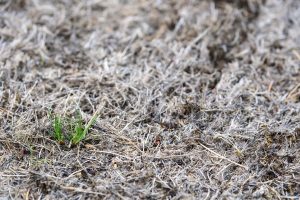 A lawn is more than just grass. It’s one of the key elements of curb appeal. However, like humans, lawns can get sick and catch diseases. A once lush lawn, left untreated, can turn into a wasteland in the blink of an eye. In this blog, we’ll discuss how to identify lawn diseases and the steps you can take to prevent them.
A lawn is more than just grass. It’s one of the key elements of curb appeal. However, like humans, lawns can get sick and catch diseases. A once lush lawn, left untreated, can turn into a wasteland in the blink of an eye. In this blog, we’ll discuss how to identify lawn diseases and the steps you can take to prevent them.
What is Lawn Disease?
Lawn disease is the disruption of grass growth by intrusive bacteria, viruses, or fungi. Because New England has a humid and continental climate and experiences all the seasons, the drastic weather changes make lawns more susceptible to catching a disease. Conditions like humidity, moisture, heat, and snow allow different fungi and bacteria species to thrive depending on the season. As a rule of thumb, if your lawn appears to be patchy, brown, or “weird” in any other way, chances are that your lawn has a disease.
Common Lawn Diseases in New England
There are several lawn diseases to be on the lookout for. These include:
- Red Thread: Stringy red or pink threads. This disease is most prevalent during the summer when it’s rainy and hot.
- Dollar Spot: Silver dollar-sized, light brown patches. It is most common when the days are warm, the air is moist, and the nights are cool.
- Brown Patch: Light brown, circular patches that appear in late spring and early fall. A moisture loving fungus causes it when there’s hot, humid weather and cool nights. Keep in mind that brown patches on your lawn can also indicate pest issues and drought.
- Snow Mold: Gray or pink patches that appear in early spring when the snow melts. Snow insulates what is underneath it in the winter, creating a moist and humid environment for fungi.
Lawn diseases can also depend on the kind of grass that you have. Read our blog, Warm Season Grasses vs. Cool Season Grasses, to determine your grass type and learn about their differences.
Lawn Disease Prevention Tips for a Healthy Lawn
Improper lawn maintenance is another culprit for lawn diseases. While lawn diseases, their causes, and their solutions can differ, there are preventative steps you can follow to minimize the risk like:
- Appropriate watering: Water deeply but infrequently, ideally in the early morning.
- Mowing practices: Mow at the right height and avoid mowing when grass is wet.
- Fertilization schedule: Use appropriate fertilizers at the right time to ensure your lawn is full of nutrients
- Improving drainage: Aerate the lawn to prevent waterlogging and improve root health with better access to oxygen and nutrients.
- Removing excess thatch: Keep thatch levels under control to avoid compaction of lawn debris in winter months that can lead to disease.
For specific lawn care tips during particular seasons, check out our blogs The 3 Most Common Landscape Problems After Winter, A New England Guide to Spring Lawn Care and Landscaping, 4 Tips to Managing Your Landscape During Late Summer, and The Best Ways to Tackle Fall Leaf Cleanup.
Like catching a cold, your lawn will probably catch a lawn disease. However, with the proper identification, you’ll be able to save your lawn and curb appeal before it’s too late. With the assistance of a reputable landscaping company like Dolan Landscaping, you can prevent lawn diseases before their onset with consistent lawn maintenance. Our other offerings, like landscape design, hardscape installation, and snow and ice services, will ensure your landscaping is well-maintained year-round. Contact us today to set up a consultation.